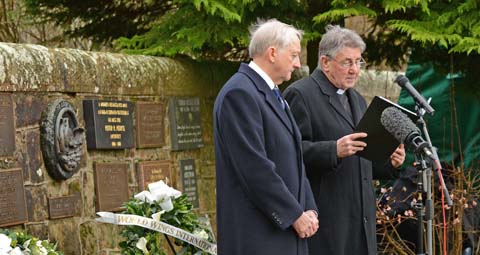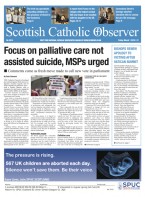December 27 | ![]() 0 COMMENTS
0 COMMENTS ![]() print
print

The night fire fell from the sky
Thirty years after the Lockerbie disaster, Mary McGinty speaks to the town’s then-parish priest Canon Keegans
The families of the victims of the Lockerbie disaster, whose loved ones perished when Pan Am Flight 103 exploded in unimaginable horror in the sky, raining down on the quiet little town, live with their loss daily.
Memories of the terrible night in December 1988 on which 270 were killed permeate their lives and the lives of the residents of Lockerbie itself.
The 30th anniversary has put the catastrophe at the forefront of the media once again as witnesses and families relive the horror. One survivor who was there at the epicentre in Sherwood Crescent had, at the time of the disaster, recently been appointed parish priest of the town’s Holy Trinity Church.
Face of tragedy
Just as the previously sleepy town suddenly found itself on the centre of the world’s stage, Canon Patrick Keegans, then Fr Keegans, soon became one of the most recognisable faces of the tragedy.
As darkness descended, and the shortest day of the year gave way to the longest night, no one could have known how just how long the night would be and the devastation it would bring.
Canon Keegans’ day had begun with a call from his friends Maurice and Dora Henry who lived just a few doors along at No 13 asking him to bring his mother over in the evening for a cup of tea after he had driven her down from Saltcoats for Christmas.
They arrived in Sherwood Crescent in late afternoon and had his mother not expressed a wish to wait at home long enough to watch the evening news they would have perished along with the Henrys and nine other residents of the crescent.
“I was upstairs when it happened and the whole house shook so much I thought I would die there,” Canon Keegans said.
“My mother, who was downstairs, was protected by the fridge freezer. At that point I thought it was a fighter plane that had come down.”
Helping victims
Opening the front door, there was only the sound of the crackling of fire to break the momentary eerie silence before the emergency services would descend, only the light of the flames illuminating the darkness which the street had been plunged into as power failed.
“The whole street was gone, it was just debris everywhere,” Canon Keegans said.
“I made an effort to get further in and I think that was symbolic. I needed to try to do something.
“With another man, I was able to carry a woman out but that was as much as we could do in Sherwood Crescent.”
As the local priest, he was soon sought out and, although in the first days he was as shocked and tearful as anyone else, his capacity for pastoral support saw him become an essential part of the grieving and healing in the wake of the atrocity.
“It was simple in some ways because I had the plus factor of living there, of being in Sherwood Crescent at the time, and they could see the sadness in my eyes. And that’s a sorrow that lasts to this day,” he said.
Media coverage
That night, as the people drew together in a local hotel, he heard one of the first reporters on the scene asking where he could find the Catholic priest.
“I didn’t have my collar on so I was incognito. I couldn’t have spoken to the media. I would just have stood there crying, I was so shocked.
“For the first week I couldn’t face a camera. Bishop Maurice Taylor came down to say Midnight Mass, which I concelebrated, although I got about four words out before I broke down,” he said.
“The first time I faced the media was to read a message of condolence from the Pope. Bishop Taylor asked me if I wanted him to stay over New Year I but I knew I had to face it.”
In another symbolic act, he took the opportunity to move back into his house on December 31, wanting to ‘show that we could live in the middle of this and come out of it.’ It was to bring a rare moment of levity.
Thinking he could smell gas, the priest ‘phoned the gas people’ in a panic. “They came right away, dug a hole outside and found a cracked pipe,” he said.
“Then the phone rang—it was someone asking me what time Mass was on New Year’s Day, so I just had to get on with it,” he laughed.
Al-Megrahi
A public life he had never sought or wanted would soon begin. It was his conviction that the families needed to know the truth to begin to heal and his belief in Adelbaset al-Megrahi’s innocence drove him forward.
Megrahi, an alleged Libyan intelligence officer, was convicted in 2001 of carrying out the bombing.
However, some remain convinced of his innocence. Canon Keegans joined the Justice for Megrahi campaign, which ended his close friendships with many of the victims families.
“I was their blue-eyed boy and then suddenly I was the traitor,” he said.
“To a large extent the relationships went but I’m still close to some of them. I couldn’t just sit back when I believed in his innocence, so my conscience is clear.”
Canon Keegans was spared the survivor guilt which often plagues those who escape death in terrible circumstances.
“I never felt guilty, only grateful to be alive and grateful my mother was alive. I did wish that I had been taken instead of the children, all of whom I knew. I conducted 10-year old Joanne’s funeral and that was very hard.”
Three decades on
Thirty years is a long time to carry the awfulness, yet he gives no sense of being haunted by it. His admiration for the families and the Lockerbie community is unbounded.
“Although it never goes away I don’t allow myself to dwell on it or my mind starts racing. Naturally, I’ve been thinking more deeply just now because of the anniversary,” he said.
“The families needed to see where the bodies had lain, how they had died, and I had great admiration for them.
“And for the local people who took them into their homes and with a grid and guidance from the authorities would help them. That was a tremendously brave thing to do.”
He is often asked why God allowed it to happen. It must be viewed within the context of free will and our capacity for good and evil, he says.
Over the years he has supported families of all faiths and none. It was his Faith that saw him through the difficult first anniversary.
“We were having an open air service outside the town hall. Four days before, I had nothing written down.
“I knew I had to wait, and then two days before I sat down at the table, it all came to me and I changed nothing. It was all given to me and that’s the way I still operate.”
He added: “How I deal with that is I don’t adjust what I say, I simply express my Faith. All I know is I wouldn’t have got through it without my Faith.”










